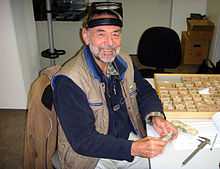Martin Pickford

Martin Pickford holds a Chair in Paleoanthropology and Prehistory at the Collège de France[1] and researcher at the Département Histoire de la Terre in the Muséum national d'Histoire.[2] In 2001 Martin Pickford together with Brigitte Senut and their team discovered Orrorin tugenensis, a hominid primate species dated between 5.8 and 6.2 million years ago and a potential ancestor of the Australopithecus genus.[3]
Some biographical details
Pickford was born in 1943 in Wiltshire, England.[4] He is the 4th child of Austin Joseph Pickford and Eleanor Margery Pickford née Holman. The family moved to Kenya in 1946. He read for his first degree between 1967 and 1971 in Dalhousie University and took a PhD at the University of London in 1975. Between 1978 and 2003 he worked at Kenya National Museums at the Muséum National d'Histoire Naturelle, Paris and as a Fellow at the University of Mainz, Germany and has since held various visiting professorships.[4]
Controversy and Discovery of Orrorin
Background
At the time of Orrorin's discovery, researchers wishing to carry out palaeontological research in Kenya were required to be affiliated with an officially sanctioned Kenyan research organisation. Prior to 1993 the only institution with this privilege was the Kenya National Museums, in which Pickford was Head of the Department of Sites and Monuments from 1978 to 1984. As such the museum and its director used to enjoy a monopoly on palaeontological research in Kenya. However, 7 years before the discovery of Orrorin in 2000, following intense pressure from the international community, the Kenyan Government liberalised many facets of the political, economic and bureaucratic life of the country, and this included the monopoly on the country's palaeontological and archaeological resources that the National Museums of Kenya and its director Richard Leakey had previously enjoyed, both prior to, and following, the country's independence in 1963.
In 1984, Pickford was congratulated in writing by the then director of the National Museums of Kenya Richard Leakey, with whom Pickford had attended high school in Nairobi, for completing three two-year contracts at the museum. Leakey informed Pickford that it was not possible to renew the contract a fourth time, as at that time there was a government-set limit placed on the quantity of such renewals. Pickford then settled in France, and in 1985, after contacting the Uganda Government, he launched the Uganda Paleontology Expedition.
From 1971 to 1978 Pickford had carried out extensive research in the Tugen Hills under a permit issued by the Kenyan Office of the President. During the surveys Pickford and his team found many important fossils ranging in age from 15 million to 2 million years old. In 1974 he found the first hominid from the 6 million-year-old Lukeino Formation (published in Nature in 1975) a lower molar which is today included in the hypodigm of Orrorin tugenensis.
On 30 October 1998, Pickford was issued a permit to carry out research in the Tugen Hills of Kenya under the auspices of the Collège de France, Paris with an affiliation to the Community Museums of Kenya. The Community Museums of Kenya, which had been founded by Eustace Gitonga and other prominent Kenyan citizens in 1997, was accredited by the Kenyan government (and therefore had the power to apply for research permits).
In 2002, Pickford and his team erected the Kipsaraman Community Museum in the Tugen Hills, which displays casts of Orrorin, along with many other spectacular fossils from the region. The original Orrorin fossils are curated by the Community Museums of Kenya, where researchers from the international scientific community are free to examine them upon request to its Director, Mr Eustace Gitonga.
Selected publications
Senut, B., Pickford, M., Gommery, D., Mein, P., Cheboi, K., & Coppens, Y. (20 January 2001). First hominid from the Miocene (Lukeino Formation, Kenya). Comptes Rendus Academie Des Sciences Paris Serie 2 Sciences De La Terre Et Des Planetes Fascicule A, 332, 137–144.
Pickford, M. (30 January 2001). The geological and faunal context of Late Miocene hominid remains from Lukeino, KenyaContexte géologique et faunique des restes d'hominidés du Miocène supérieur de Lukeino, Kenya. Comptes Rendus De L'académie Des Sciences – Series Iia – Earth and Planetary Science, 332, 2, 145–152.
Pickford, M. (1997). Louis B. Leakey: Beyond the evidence. London: Janus Pub. Co.[5]
Sources
- "Orrorin tugenesis". 16 September 2001. Retrieved 26 November 2007.
- Regal, Brian (2004). Human evolution: A guide to the debates. Santa Barbara, California, USA: ABC-CLIO.
External links
- Works by or about Martin Pickford in libraries (WorldCat catalog)
References
- ↑ Senut, B., Pickford, M., Gommery, D., Mein, P., Cheboi, K., & Coppens, Y. (January 20, 2001). First hominid from the Miocene (Lukeino Formation, Kenya). Comptes Rendus Academie Des Sciences Paris Serie 2 Sciences De La Terre Et Des Planetes Fascicule A, 332, 137–144.(Accessed Aug 2012)
- ↑ [http://www.mnhn.fr/publication/geodiv/g03n2a9.pdf Pickford, M. and Morales, J. (2003) New Listriodontinae (Mammalia, Suidae) from Europe and a review of listriodont evolution, biostratigraphy and biogeography, GEODIVERSITAS,,25, Publications Scientifiques du Muséum national d’Histoire naturelle, Paris
- ↑ Haviland, William A.; Prins, Harald E. L.; Walrath, Dana; McBride, Bunny (2007). Evolution and prehistory: the human challenge. Cengage Learning. ISBN 0-495-38190-X.
- ↑ 4.0 4.1 Johannes Gutenberg University of Mainz: Dr. Martin Pickford (Accessed Aug 2012)
- ↑ Van, C. J. A. (1 January 1999). BOOK REVIEW: Louis S. B. Leakey: Beyond the Evidence. Edited by Martin Pickford, Ph.D. Janus Publishing Company, London, 1997, xxiv + 164 pp., 16 color figs (paper), £12.00. International Journal of Primatology, 20, 2, 291–294.
|